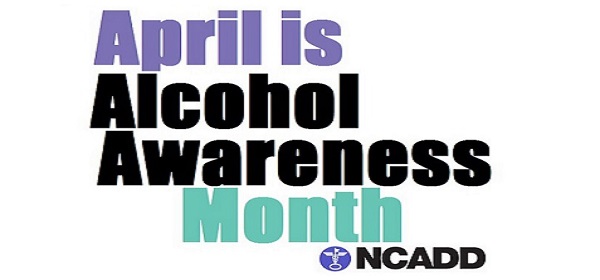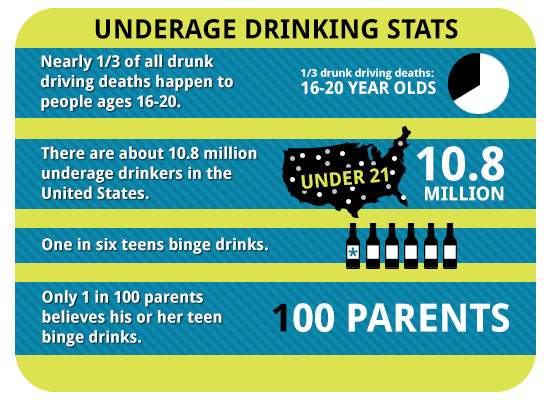Alcohol Awareness Month “Talk Early, Talk Often”

Each April since 1987, the National Council on Alcoholism and Drug Dependence (NCADD) sponsors Alcohol Awareness Month to increase public awareness and understanding, reduce stigma often associated with alcoholism and encourages local communities to focus on alcoholism and alcohol-related issues. This April NCADD highlights the importance of “Talk Early, Talk Often”. The hope of the 2016 theme is to draw attention to the role parents and educators play in preventing teen alcohol use.
A Dive Into Teens Driving In New York
Drivers under the age of 21 account for fewer than 10 percent of licensed drivers in New York. However, they account for a full 14 percent of DUI related fatalities. From my perspective having been in treatment and recovery for an opiate addiction, I predict that these statistics will be grimmer in the years to come unless more is done to attack the problem of underage drinking.
Source: www.centurycouncil.org/state-facts/new-york.

To make matters worse, binge drinking among teens is on the rise. The following statistics are alarming:
- Alcohol is the most commonly used and abused drug among youth in the United States.
- Excessive drinking is responsible for more than 4,300 deaths among underage youth each year, and cost the U.S. $24 billion in economic costs in 2010.
- Although drinking by persons under the age of 21 is illegal, people aged 12 to 20 years drink 11% of all alcohol consumed in the United States. More than 90% of this alcohol is consumed in the form of binge drinks.
- On average, underage drinkers consume more drinks per drinking occasion than adult drinkers.
- In 2010, there were approximately 189,000 emergency room visits by persons under age 21 for injuries and other conditions linked to alcohol.
Source: http://www.cdc.gov/alcohol/fact-sheets/underage-drinking.htm
New York’s Zero Tolerance Overview
New York is a Zero Tolerance state, meaning that anyone under the age of 21who is caught driving with a Blood Alcohol Concentration (BAC) as low as .02 can lose their license even if they were not impaired. The penalty is civil in nature, not criminal, but regardless, it clearly was designed to send a strong message that no amount of drinking and driving by individuals under 21 is permitted.
Source: Vehicle and Traffic Laws sections 1192-a and 1194-a
Young Drivers and Higher Death Rates
In a 2012 study conducted by the Centers for Disease Control, researchers found that drivers aged 16 to 20 are 17 times more likely to be killed when they have a blood alcohol concentration of .08 or higher, versus if they were sober. It’s estimated that one million high school students per year operate a motor vehicle after drinking alcohol. The CDC study also found that, “teen drivers are 3 times more likely than experienced drivers to be in a fatal crash.” Also, “among drivers with BAC levels of 0.08 % or higher involved in fatal crashes in 2013, one out of every 3 were between 21 and 24 years of age (33%).”
Source: http://www.cdc.gov/motorvehiclesafety/impaired_driving/impaired-drv_factsheet.html
We know that people’s brains aren’t fully developed until their early 20s. Alcohol and other drugs can have a deleterious effect on teens during this development period, impacting rational decision making, memory, and other faculties. Mothers Against Drunk Driving reports that adolescent drinkers “perform worse in school, are more likely to fall behind, and have an increased risk of social problems, depression, suicidal thoughts, and violence.”
Source: http://www.madd.org/?referrer=https://www.google.com/
What Can Be Done To Stop Teens From Drinking and Driving
What can be done to eradicate the teen drinking and driving problem? Clinicians who treat teen addiction and alcoholism agree that early intervention is the key. The goal must be to get to middle school and high school students before they start experimenting with alcohol and before they are eligible for a driver’s permit or license.
Source: http://pubs.niaaa.nih.gov/publications/arh283/163-174.pdf
“Early intervention” means entering addiction treatment before bottoming out and before the addiction becomes so habitual that it is almost impossible to cure. Some experts recognize four stages of alcohol or drug addiction. In stages one and two, the teen uses the substance in a social setting. In stage three, the teen starts to arrange his life around drugs. In stage four, the focus of the teen’s day is “getting high.”
Addiction treatment works best if the teen enters in stage one or two.
We must educate teens about the dangers of drinking before their brains are fully developed, and how drinking at an early age results in arrested development and problems later in life. Education is critical, but more than just education is required.
Personal Recovery Perspective From Andrew McKenna
Andrew McKenna, our Legal Advocate, and Author of Sheer Madness: From Federal Prosecutor to Federal Prisoner, provides his personal perspective on teens and recovery.
From a personal recovery stand point, I watched during group therapy sessions for addiction, how therapists would explain to patients the need to retool their thinking. For instance, a big hurdle for many people in recovery, especially teens, is to recognize that they can have fun without alcohol or drug consumption. One guy, probably 17, told the group that he was really into video gaming, and that he hadn’t played a game without being high since he was 12 years old. To progress in his, he had to adjust his thinking and realize that the gaming experience can be just as enjoyable without being high. It’s my experience that most people in the throes of addiction plan all of their activities around using or drinking. Going to a baseball game, for instance, involves drinking beer. Going to a club includes doing cocaine. Going fishing involves drinking and smoking pot. Coming to understand these recovery pit-falls helps people to learn new behaviors to achieve happiness without the mind altering component.
Perhaps the most important thing we can do is to require all teens, prior to getting their permits, to attend a Victim Impact Panel. Currently in New York, and most states, a person convicted of drunk driving has to attend such a panel. Members of the community who have lost loved ones to drunk driving discuss the great emotional impact the deaths had on them. These panel sessions are brutal in their honesty. Rarely is there a dry eye in the room as a father who lost his only child to a drunk driver recounts the story. The drunk driver that night happened to be his daughter’s best friend. She lost control of the car which was traveling at a high rate of speed, and hit a wall. The man’s daughter was thrown through the windshield and killed instantly. The father, with tears running down his face, tells the crowd, it was his daughter 16th birthday. Powerful. Teens react to real events, real stories, whereas they rarely respond to lectures about health related issues.
Source: http://www.madd.org/local-offices/ny/victim-impact-panels.html
More can and should be done to stop teen drinking and driving. I speak to schools and community leaders about my struggles with prescription pain medication, and eventually heroin addiction. Schools and community organizations are trying to focus on combating the heroin epidemic in this country. This of course is great news. However, we need to ensure that we put equal effort into raising awareness about drinking and driving as well.
One approach would be to focus attention on where the minors are obtaining the alcohol in the first place. We should educate adults, who may think it’s not a big deal to buy alcohol for teens, about the consequences of providing alcohol to a minor. New York State Penal Code section 260.20 prohibits this conduct. The offense is a Class A Misdemeanor carrying a sentence of up to a year in jail.
The statute provides in relevant part:
A person is guilty of unlawfully dealing with a child in the first degree when: He gives or sells or causes to be given or sold any alcoholic beverage, as defined by section three of the alcoholic beverage control law, to a person less than twenty-one years old; except that this subdivision does not apply to the parent or guardian of such a person or to a person who gives or causes to be given any such alcoholic beverage to a person under the age of twenty-one years, who is a student in a curriculum licensed or registered by the state education department, where the tasting or imbibing of alcoholic beverages is required in courses that are part of the required curriculum, provided such alcoholic beverages are given only for instructional purposes during classes conducted pursuant to such curriculum.

Conclusion
Teens who start using alcohol and other drugs at an early age have a much greater chance of developing addiction problems later in life. I myself had this experience. The issue of teen drinking and driving must be met head on with education programs for students and adults about the very real life long consequences. Mandatory attendance to a Victim Impact Panel prior to issuance of permits and licenses is a good start. Real people telling real stories resonate with young people. I see it in their eyes when I speak at their schools. It’s an eye opener and lays the ground work for making healthier, smarter choices in their lives as they mature.
The exclusive purpose of this article is educational and it is not intended as either legal advice or a general solution to any specific legal problem. Corporate offices for Nave DWI Defense Attorneys are located at 432 N. Franklin Street, Suite 80, Syracuse, NY 13204; Telephone No.: 1-866-792-7800. Prior results do not guarantee a similar outcome. Attorney Advertising.


